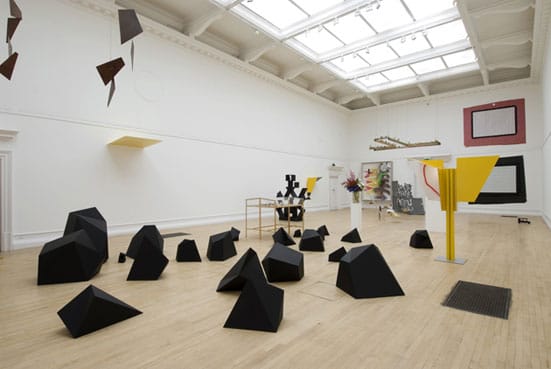2nd May 2007 — 24th June 2007
Until
24 June when Stay Forever and Ever and Ever like all things will pass,
this ambitious exhibition at South London Gallery brings together
eleven international artists in response to ideas about memory and
objects, objects and their reception. Entering Stay Forever and Ever
and Ever is a bit like opening a neglected cupboard and being
physically confronted by objects hidden and long forgotten; the visitor
descending the gallery steps is pinioned immediately by a two-pronged
intervention. Monika Sosnowska's installation Untitled, 2006 confronts
us up ahead and Martin Boyce's Frozen Fall, 2007 from above.
Sosnowska's sculptural works, a collection of 22 black objects that
resemble misshapen plinths or props, litter the entrance and impede the
obvious path into the exhibition; Boyce's steel and wire construction
hangs over the doorway like a threat.
Works included in the exhibition sometimes draw upon commonplace and
recycled materials and offer ready cultural references and sources.
However this is an exhibition that hopes for an intuitive viewer who
will negotiate connections between objects; the written materials that
accompany the exhibition are suggestive rather than instructive and the
title taken from a repetitive Kylie Minogue refrain is evocative rather
than didactic. Memory is a contentious and continually debated field
and Stay Forever and Ever and Ever curated by Andrew Renton, director
of the MFA Curating programme at Goldsmiths' College, positions itself
as a response rather than a theoretical intervention.
Some objects act as useful markers as we begin to negotiate this
ambiguous collection. Michael Fullerton's Seminal Event (Vidal Sasson
Corp. Executive Board 1968), 2007, a triptych of screen-prints showing
the same banal image but fading slightly with each repetition, presents
a snapshot of the problem of remembering the past event and speaks of
the compulsion to archive. With this in mind Georg Herold's Rude
Museum, 1993, a museum case containing the fragments of objects in
daily use: a rusted mirror, a broken watch strap, the nib of a pen,
becomes a poignant and desperate representation of this archival
tendency in personal life.
However the exhibition is most ambitious in the inclusion of awkward
objects that invoke their own past lives. Hokusai's Octupai, 2004 and
The Wall, 2003, amateurish theatrical props made for past performances
by Spartacus Chetwynd are now presented detached from their original
context and with minimal explanation. Out of proper time and place,
Chetwynd's objects become inexplicable signifiers of the absent event.
Marten Baas' Smoke, 2004, inhabits a similarly ambiguous position in
relation to other artworks. Baas, better known as a designer has
reworked an Ettore Sottsass-designed piece of furniture by burning it
into a charcoaled version of the 'room divider'; his new object
presents an uncomfortable image of the domestic where violence is
perceptible at the surface.
However some works manage only a nostalgic appropriation of
materials and references and do not succeed in resituating them or
gaining critical leverage. Abraham Cruzvillegas' wooden assemblage
topped by broken bottles supports a chaotic mobile of further daily
detritus and seems simply to delight in its materials; unlike Georg
Herold's museum it fails to transform ephemera into something more
permanent or meaningful. Jeroen de Rijke and Willem de Rooij's piece
Bouquet II, 2003, a regularly refreshed bunch of flowers chosen for
their specific cultural resonances simply looks pretty amid the
collection and its conceptual basis is lost in the jostle with other
more substantial works. However with its emphasis on evoking
connections rather than drawing conclusions, Stay Forever and Ever and
Ever seems willing to support the inevitable problems inscribed in its
ambitious themes. A new configuration of past works by Andreas
Slominski introduces the motif of the trap into the visual landscape: a
small model hearse sits on the gallery floor with a mousetrap jammed
inside while a ceramic receptacle Untitled (Bird Trap), 1997 is
discreetly placed above a gallery door opposite. The pair of traps
became for me the memorable image of Stay Forever and Ever and Ever, an
exhibition that presents a treacherous terrain that we navigate
awkwardly and thoughtfully.
SH
South London Gallery
65 Peckham Road
London SE5 8UH
http://www.southlondongallery.org
Open
Tuesday-Sunday, 12-6pm

Installation View
Stay Forever and Ever and Ever
Curated by Andrew Renton
South London Gallery
2007